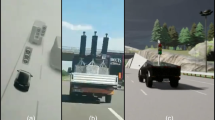Abstract
The concept presented for the management of distributed dynamic systems is based on installing in all system components of a universal intelligent module interpreting special high-level language, in which any centralized or distributed control can be expressed. The mission scenario in the language, starting from any interpreter, is collectively executed by their network. The interpreters perform appropriate operations in nodes, while passing other parts of the scenario, together with intermediate data, to other interpreters in a coordinated manner. This process covers the system at runtime, and sets up distributed command and control infrastructures providing the overall integrity and goal orientation. This approach allows us to manage robotized systems in unpredictable and hostile environments, with possible failures of components. The language description and programming examples in it are provided.
Similar content being viewed by others
References
Sapaty P, Sugisaka M, Finkelstein R, et al. (2006) Advanced IT support of crisis relief missions. J Emergency Manag 4(4):29–36
Tierney K (2003) Disaster beliefs and institutional interests: recycling disaster myths in the aftermath of 9–11. Terrorism and disaster: new threats, new ideas. Research in social problems and public policy, vol 11. Elsevier, Anis Tesclam, pp 33–51
Tierney K, Bevc C, Kulikovski E (2006) Metaphors matter: disaster myths, media frames, and their consequences in hurricane Katrina. Ann Am Acad AAPSS 604:57–81
The Cooperative Engagement Capability (1995) John Hopkins APL, Technical Digest, vol 16, No 4, pp 377–396
Lambert DA (1999) Ubiquitous command and control. Proceedings of the 1999 Information, Decision and Control Conference, Adelaide SA, Australia, ISBN: 0-7803-5256-4, pp 35–40
Lambert DA, Scholz JB (2005) A dialectic for network centric warfare. Proceedings of the 10th International Command and Control Research and Technology Symposium (ICCRTS), MacLean, VA, 45 pp
Sapaty PS (1999) Mobile processing in distributed and open environments. Wiley, New York, 436 pp
Sapaty PS (2005) Ruling distributed dynamic worlds. Wiley, New York, 256 pp
Sapaty P (2006) Crisis management with distributed processing technology. Int Trans Syst Sci Appl 1:81–92
Dragos S, Collier M (2004) Macro-routing: a new hierarchical routing protocol. Proceedings of the 47th Annual IEEE Global Telecommunications Conference, Globecom 2004, Nov. 29–Dec. 3, Dallas, Texas, USA, pp 77–82
Dragos S-M (2006) Scalable QoS routing in MPLS networks using mobile code. PhD Dissertation, School of Electronic Engineering, Dublin City University, 235 pp
Gonzalez-Valenzuela S, Leung V (2002) QoS-routing for MPLS networks employing mobile agents. IEEE Network Mag 16(2): 16–21
Author information
Authors and Affiliations
Corresponding author
About this article
Cite this article
Sapaty, P., Morozov, A., Finkelstein, R. et al. A new concept of flexible organization for distributed robotized systems. Artif Life Robotics 12, 88–96 (2008). https://doi.org/10.1007/s10015-007-0447-7
Received:
Accepted:
Published:
Issue Date:
DOI: https://doi.org/10.1007/s10015-007-0447-7




